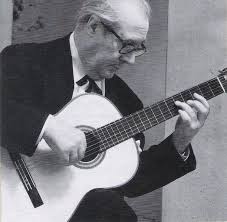Austin Kleon's fifth bullet point in Steal Like an Artist is "side projects and hobbies are important". His thesis is that if your are a writer, you shouldn't only write. If you are a painter, you shouldn't only paint. And if you are a musician you shouldn't only play music.
Occasionally, artists will devote time to a singular passion with great success. Andrés Segovia, the pioneering classical guitarist, was devoted to the cause of elevating his instrument to the status of the concert hall. I could be wrong but I don't think Segovia dabbled in many "side projects and hobbies". His singular devotion to the classical guitar was so great that it is said he even practiced for 3 hours on the morning when he died (age 94).
 |
| Andres Segovia (1893-1987) |
Now if Segovia was involved with painting, dance, or poetry as a side project, would that have opened him up to new ideas and interpretations? Or would he have lost valuable focus time and would not have had the impact on the guitar world that he did? I don't know. There is a fear that some of us have about side projects and the road to mastery. The "Jack of All Trades, Master of None" can be a compliment or a slam depending on your perspective. However, I am finding more artists who need to explore all of what life has to offer, beyond just their art. And those side projects can make you see your main project in a different light.
By exploring other mediums, arts, philosophies, and hobbies you will discover interesting connections that encourage divergent thought. You will make connections that can enhance your own art. Occasionally, you may be able to fuse the two together in exciting ways.
Of course, if you have the inclination to be a "dabbler" (as George Leonard describes in his book "Mastery") you want to tread carefully here. These side projects may have a tendency to become the dabbler's siren song. You will keep looking for the hot new hobby to explore and get all excited about, as opposed to mastering what you have already undertaken. There is a fine line here.
Nonetheless, it is clear that many artists find refuge in their side projects. Here is a short list of famous musicians and their extended hobbies/interests:
Joe Diorio, jazz guitarist - painting
Steve Vai, rock guitarist - beekeeping
David Bowie, rock musician - chess
Mos Def (Yaslin Bey), hip hop artist - acting
Neil Young, rock musician - model railroading
Frank Sinatra, jazz crooner - crossword puzzles
Johnny Greenwood, guitarist for Radiohead - chicken rearing
Jim Martin, guitarist for Faith no More - pumpkin farming
John Coltrane, jazz saxophone - inter-religious studies
Don Glen Viot (Captain Beefheart), avant-garde rock muscian - painting
Patti Smith, punk rock musician - poetry (good poetry, too!)
And my favorite:
 |
So think about the side project you would love to explore or return to and get to it. And you don't have to limit it to just one thing. There is a lot of knowledge out there to discover and a lot of things to create.
And for a more open-ended perspective: the following is from an interview in Downbeat magazine where jazz pianist Thelonious Monk provides his take on hobbies:
Interviewer: What other interests do you have?
Monk: Life in general.
Interviewer: What do you do about it?
Monk: Keep breathing.

No comments:
Post a Comment